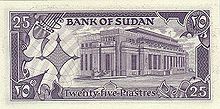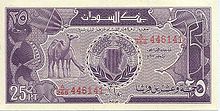Sudanese pound
| Sudanese pound | |
|---|---|
| Country: |
|
| Subdivision: | 100 piastres |
| ISO 4217 code : | SDG |
| Abbreviation: | sud £ |
|
Exchange rate : (28 Aug 2020) |
1 EUR = 65.345 SDG 1 CHF = 60.786 SDG |
The (new) Sudanese pound ( Arabic جنيه سوداني dschineh sudani ) has been the currency of Sudan since January 9, 2007 and, after a transition period until June 30, 2007, replaced the Sudanese dinar at a ratio of 100 to 1. In 1991 the dinar had the (old) Sudanese pound (SDP) at a ratio of 10 to 1 replaced.
The new Sudanese pound exists in coins of 1, 5, 10, 20 and 50 piastres and in banknotes of 1, 2, 5, 10, 20, 50, 100 and 200 pounds.
history
The Sudanese pound was introduced in 1956 with the establishment of the Republic of Sudan and independence from Egypt . A Sudanese pound was divided into 100 piastres or 1000 millimetres ( millièmes ).
Due to the economic crisis, the Sudanese dinar was introduced in 1991. A Sudanese dinar was exchanged for 10 Sudanese pounds. The South Sudan region , which was at war with the central government in Khartoum at the time, rejected the currency conversion and kept the Sudanese pound as a means of payment.
Until the introduction of the new pound, prices were still mostly given in old pounds in everyday life, even in the north of the country, but since the end of the 1990s they have only been paid in dinars.
In the course of the peace agreement between the South Sudanese rebels and the government in Khartoum in 2005, it was decided to reintroduce the Sudanese pound as a new currency throughout Sudan. The “new” pound replaced the “old” pound, which was still partially used in South Sudan, at a ratio of 1 to 1000 and the dinar at a ratio of 1 to 100. The implementation should have taken place at the end of 2005 / beginning of 2006, but was due to funding problems in the donor countries delayed. The Sudanese government, together with the SPLM government in the autonomous South Sudan, decided in May 2006 to finance it with the aid of the country's oil revenues and to gradually introduce the “new” pound from January 10, 2007.
After gaining independence in 2011, South Sudan introduced the South Sudanese pound as its own currency. In Sudan the banknotes from 5 to 50 pounds were then reissued in a different color.
Web links
Individual evidence
- ↑ Helmut Kahnt, Bernd Knorr: Old dimensions, coins and weights. A lexicon. Bibliographisches Institut, Leipzig 1986, licensed edition Mannheim / Vienna / Zurich 1987, ISBN 3-411-02148-9 , p. 379.
- ↑ Sudan Tribune: "New Sudan currency to circulate from January 10" (from January 9, 2007)
- ↑ Toby Collins: North and South Sudan: two new countries, two new currencies , in: Sudan Tribune, July 12, 2011
- ↑ Pictures of the banknotes of Sudan


